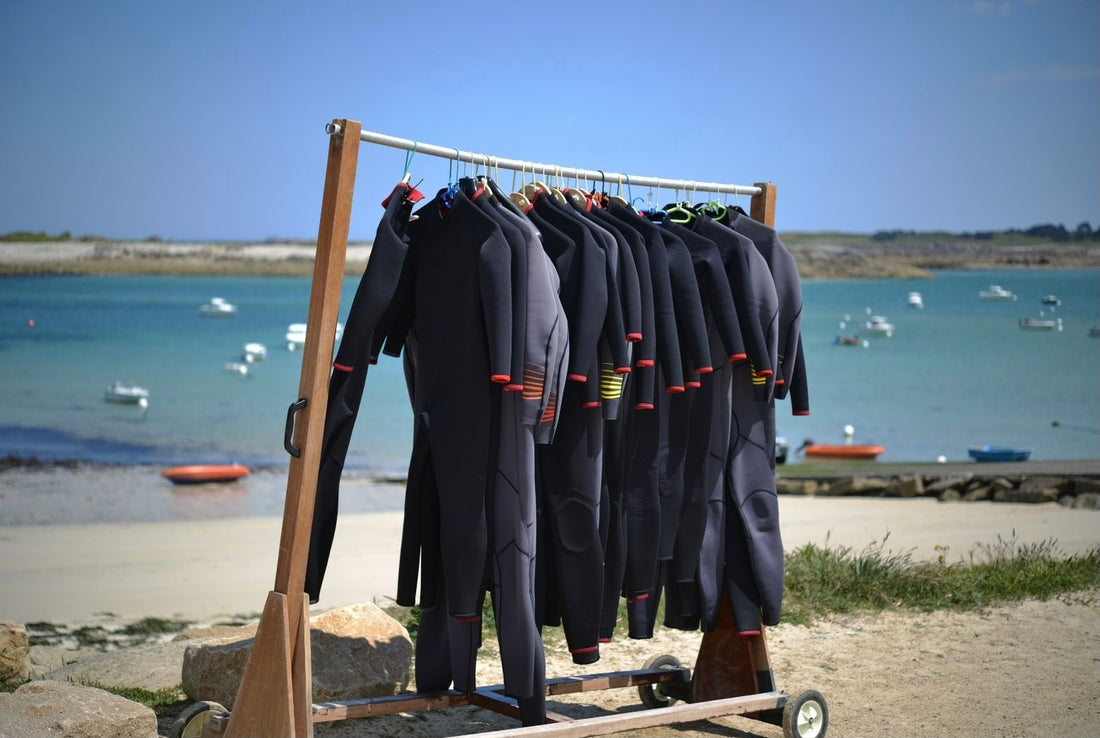Looking after your wetsuit and storing it well during an extended surface interval will help keep it in great condition.
Neoprene is a pretty impressive form of foam rubber. It’s made up of tiny bubbles of gas (nitrogen isn’t just in the air we breathe, it’s in a lot of these bubbles too) and it’s these bubbles that help keep us warm. They do this by slowing the transfer of our body heat to the water. It’s these gas-filled bubbles that also make our wetsuits buoyant. It’s also these gas-filled bubbles that we need to look after to ensure the longevity of our wetsuit.
Show your wetsuit some love knowing what it likes and what it doesn’t and it will return that love by lasting you a very long time.
Your wetsuit adores:
A cool water wash straight after use and being dried out of the sun. Bonus if there is a slight breeze! Hang it inside out on a thick, padded hanger. A wire one can stretch it. If possible, bend it in half over the hanger rather than putting the shoulders through as the weight of the neoprene when it’s wet can stretch it further.
Cleaning products made especially for neoprene. Conventional detergents can destroy the neoprene over time. If you don’t have neoprene-specific products, a bit of baby shampoo can work well too. Don’t do this often though.
Being properly dry between dives - there is nothing quite like the smell of a wetsuit that has been stored slightly damp. That mildew that grows, the stench it makes.... nothing pleasant. If it’s already been stored damp, it’s time for a deep clean! There are also deodorizers designed especially for neoprene. These odor-eating microbes, enzymes and some other bits and pieces actually dine on the bad smell at the source ie they eat the mildew and

Being stored when not in regular use. A non-used wetsuit laying around the house takes up a lot of visual space so it’s good to put it away and keep the non-divers in your household happy (or convert them all to divers though this may take a little longer than putting your wetsuit away). If possible, store it hanging up on a large, wide hanger with your wetsuit draped over it rather than the shoulders on it. This is to prevent stretching. If you need to store it in a drawer lay it front down and cross the arms over the back of it. Take a cardboard tube (eg a wrapping paper tube) across the bum and take the legs to the neck and store flat. If you’re traveling with it and it needs to go in your suitcase, start with it lying face up and check the zip is done up. Fold in the arms. Tightly from the legs up. Use the long zipper puller thing to wrap around your neatly rolled wetsuit to keep it all in place. Hang it as soon as you get to your destination.
Your wetsuit dislikes:
Creases - wherever there is a crease, the insulation qualities are reduced because the tiny gas-filled bubbles are squashed. Many new wetsuits will have a fold in them somewhere. Don’t panic, it is possible to get rid of them without using an iron and it’s no reason to not buy that wetsuit unless it’s a really, really deep crease.
For fairly minor creases and wrinkles, just wearing it is likely to remove them. To help the process further, get it wet while you’re in it rather than just walking around the house looking like you’re auditioning for the next James Bond film.
For those more hardcore creases, there are two methods. First lay it out over a flat surface, give it a bit of a stretch and flatten the creases with your hands. Put a book or two on it to help it stay a bit stretched and leave it for a day. Second, if that hasn’t worked, stretch the material a little bit again and keep it taut for another day. This should help the bubbles bounce back to their former glory.
Heat - no ironing, direct sunlight or leaving it in your car for a long period of time. No ironing because the wetsuit will melt. It is rubber after all! Long exposure to direct sunlight erodes the rubber.

Chlorine - yes, some of us do pool sessions for confined water portions of courses or to refresh skills so it can be unavoidable so remember to rinse your wetsuit well after this. Chlorine can eat away at the neoprene and it makes your wetsuit smell terrible!
Salt water - ironic given that’s where most of us wear our wetsuits so remember to rinse it well and it won’t mind the ocean dive. It’s actually the zips, the stitching and the non-neoprene parts that generally prefer freshwater to salt.
Best to hand wash in cool or lukewarm water, follow the care instructions on your particular wetsuit. If you need to use a detergent, make sure it’s one specifically for neoprene so your wetsuit will last longer.
Washing machine / tumble dryer - this can stretch and tear your wetsuit and the heat from either machine is also not great unless you would like to have a melted wetsuit.
Anything chemical - aerosols, solvents, oils etc - it stains and makes the bubbles weak. Use a water-based lubricant if you need something to help you put it on, or roll it on inside out, or wear skins.
Being folded - those pesky creases will flatten the bubbles and there goes your warmth on your next dive.
We wish you a long and happy relationship with your wetsuit as it looks after you while you look after it.
Happy diving!

